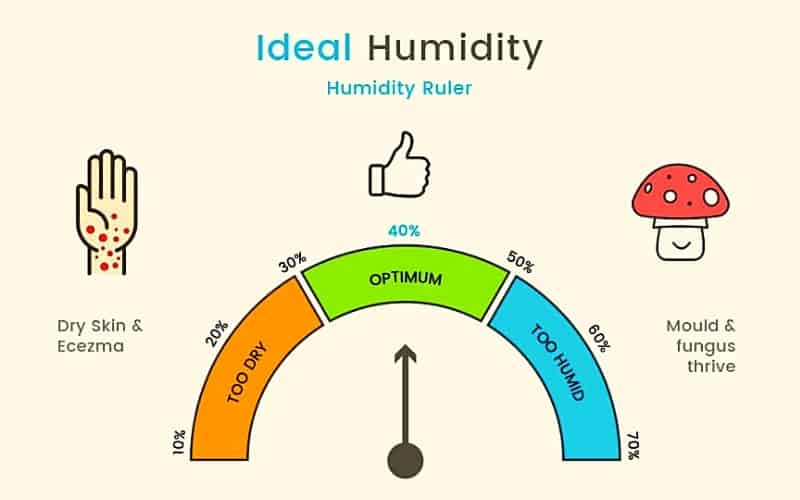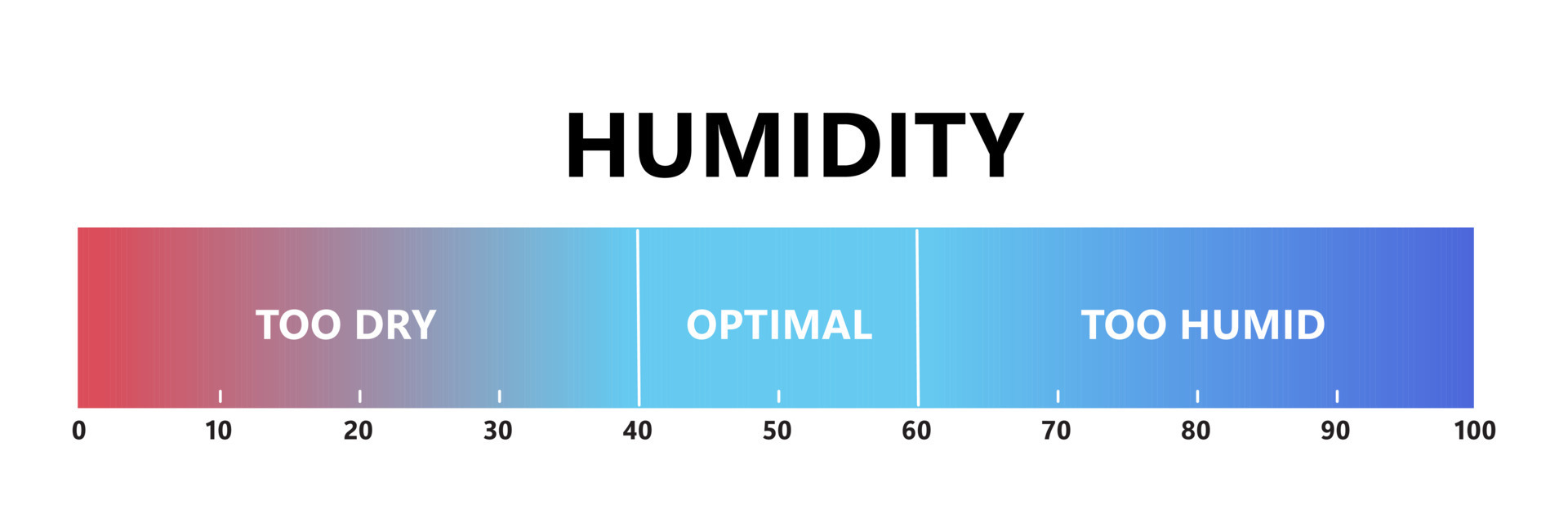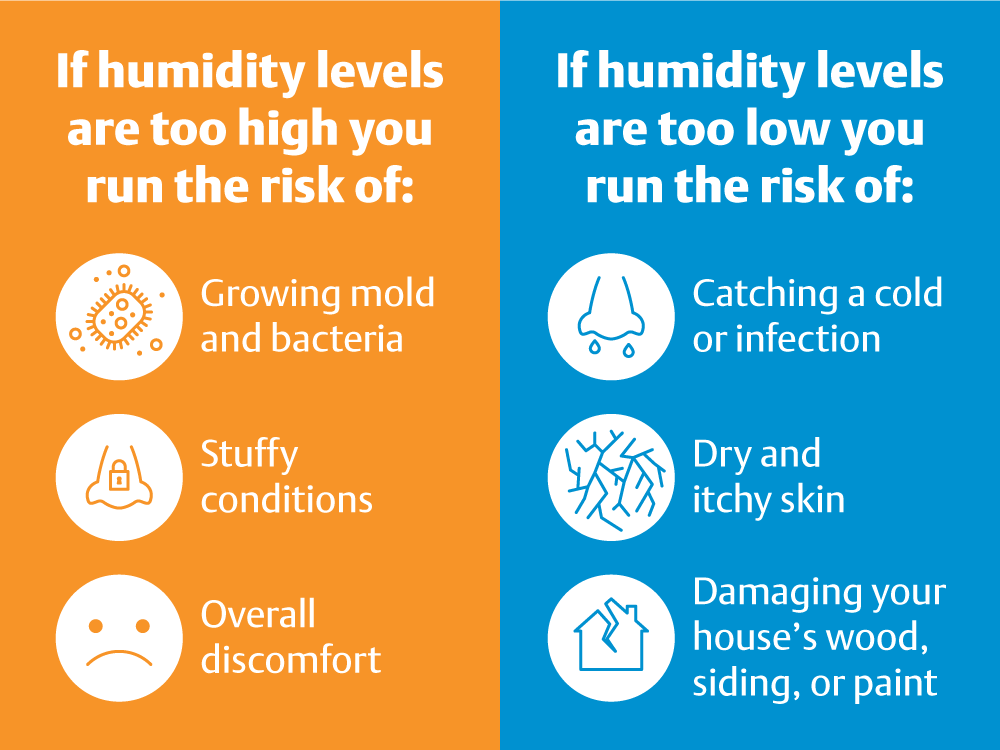How Much Humidity Is Too Much In A House

Humidity, the amount of moisture in the air, plays a crucial role in our comfort and well-being within our homes. While some humidity is essential for preventing dry skin and respiratory issues, too much can lead to a host of problems. Understanding the ideal humidity range and recognizing the signs of excessive moisture is key to maintaining a healthy and comfortable living environment.
What is Humidity and Why Does It Matter?
Humidity refers to the concentration of water vapor present in the air. It's often expressed as relative humidity (RH), which represents the amount of moisture in the air compared to the maximum amount the air can hold at a specific temperature. Think of it like a sponge: if a sponge is half-full of water, it has 50% relative humidity.
Our bodies regulate temperature through perspiration. When sweat evaporates, it cools us down. However, when the air is already saturated with moisture (high humidity), sweat doesn't evaporate as efficiently. This makes us feel hotter and stickier, even if the actual temperature isn't that high. Conversely, low humidity can lead to dry skin, cracked lips, and increased susceptibility to respiratory infections.
The Ideal Humidity Range for Your Home
The generally recommended relative humidity range for indoor comfort is between 30% and 50%. This range is considered optimal for both human health and preventing structural damage to your home. During the winter months, it's often necessary to keep humidity levels lower (closer to 30%) to prevent condensation on windows, which can lead to mold growth. In the summer, levels can be slightly higher (up to 50%), but should ideally stay below 60%.
Why is 30-50% Considered Ideal?
- Comfort: This range allows for efficient sweat evaporation, keeping you comfortable in both warm and cool weather.
- Health: It minimizes the survival and spread of dust mites, mold, and other allergens that thrive in high humidity. It also prevents dryness-related issues like dry skin and respiratory irritation.
- Protection of Property: It reduces the risk of condensation, which can damage walls, ceilings, and floors, and contribute to wood rot and pest infestations.
Signs of Too Much Humidity in Your House
Recognizing the signs of excessive humidity is crucial for taking timely corrective action. Here are some common indicators:
- Visible Mold or Mildew: This is perhaps the most obvious sign. Look for dark, fuzzy patches on walls, ceilings, window sills, or in bathrooms. Mold thrives in damp environments.
- Condensation on Windows and Mirrors: If you frequently see condensation forming on the inside of your windows, especially during colder months, it's a strong indication that your indoor humidity levels are too high. Similarly, if mirrors in bathrooms remain fogged up long after a shower, it suggests poor ventilation and excessive moisture.
- Musty Odors: A persistent musty or earthy smell is a telltale sign of mold or mildew growth, even if you can't see it.
- Water Stains: Look for water stains on ceilings, walls, or floors, especially around bathrooms, kitchens, and basements. These stains indicate water leaks or condensation problems.
- Peeling Paint or Wallpaper: High humidity can cause paint to peel, blister, or crack. Wallpaper may also start to peel away from the walls.
- Warped Wood: Excessive moisture can cause wood floors, furniture, and trim to warp, swell, or rot.
- Increased Allergies or Respiratory Problems: High humidity can exacerbate allergies and asthma symptoms. You may experience increased coughing, sneezing, wheezing, or difficulty breathing.
- Sticky or Clammy Feeling: As mentioned earlier, high humidity prevents sweat from evaporating efficiently, making you feel sticky, clammy, and uncomfortable.
- Insect Infestations: Many insects, such as dust mites, cockroaches, and silverfish, thrive in humid environments.
The Dangers of Excessive Humidity
The consequences of unchecked high humidity can extend beyond mere discomfort. It can seriously impact your health and the structural integrity of your home.
- Health Problems: Mold exposure can trigger allergic reactions, asthma attacks, and other respiratory problems. Some molds produce mycotoxins, which can have serious health effects. High humidity also encourages the growth of dust mites, a major allergen.
- Structural Damage: Excessive moisture can rot wood, corrode metal, and damage insulation, leading to costly repairs. It can also weaken the structural integrity of your home over time.
- Reduced Energy Efficiency: High humidity makes it harder to cool your home, forcing your air conditioner to work harder and consume more energy. This translates to higher energy bills.
How to Measure Humidity Levels
The easiest way to measure the humidity level in your home is with a hygrometer (also known as a humidity meter). These devices are relatively inexpensive and readily available at most hardware stores and online retailers. There are two main types of hygrometers:
- Digital Hygrometers: These devices provide a digital readout of the relative humidity. They are generally more accurate and easier to read than analog models.
- Analog Hygrometers: These devices use a dial to indicate the relative humidity. They are often less expensive but may be less accurate.
To get an accurate reading, place the hygrometer in a central location away from direct sunlight, heat sources, and drafts. Monitor the humidity levels in different areas of your home, especially in bathrooms, kitchens, and basements. Record your readings regularly to track changes over time.
How to Reduce Humidity Levels in Your Home
Fortunately, there are several effective strategies for reducing humidity levels in your home.
- Use Exhaust Fans: Run exhaust fans in bathrooms and kitchens while showering, cooking, and washing dishes. These fans vent moist air outside, preventing it from spreading throughout the house. Ensure your exhaust fans are properly vented to the exterior.
- Vent Your Clothes Dryer: Make sure your clothes dryer is properly vented to the outside. A dryer that vents into your home will release a significant amount of moisture into the air.
- Fix Leaks: Repair any leaky faucets, pipes, or roofs promptly. Even small leaks can contribute to high humidity levels over time.
- Improve Ventilation: Open windows and doors regularly to allow fresh air to circulate. This is especially important during milder weather. Consider installing whole-house ventilation systems if necessary.
- Use a Dehumidifier: A dehumidifier removes moisture from the air. Dehumidifiers are particularly useful in basements and other damp areas. Choose a dehumidifier with the appropriate capacity for the size of the room.
- Air Conditioning: Air conditioning systems not only cool the air but also remove moisture. Ensure your AC system is properly sized for your home and that it's functioning efficiently. Think of refrigerant as the "blood" of your AC system, carrying heat from inside to outside. Low refrigerant means the system can't cool effectively, and consequently, won't dehumidify as well.
- Improve Insulation: Proper insulation helps to regulate temperature and reduce condensation. Insulate walls, ceilings, and floors, especially in basements and attics.
- Cover Soil in Crawl Spaces: If you have a crawl space, cover the soil with a vapor barrier to prevent moisture from seeping into your home.
- Address Standing Water: Eliminate any sources of standing water around your home, such as clogged gutters or drainage issues.
- Properly Store Firewood: Keep firewood stored outdoors and away from your house to prevent moisture from entering your home.
- Consider a Whole-House Dehumidifier: For persistent humidity problems, especially in larger homes, consider installing a whole-house dehumidifier that integrates with your HVAC system.
When to Call a Professional
While many humidity problems can be addressed with simple DIY solutions, there are times when it's best to consult a professional.
- Persistent Mold Problems: If you have a significant mold problem that you can't control with cleaning and ventilation, it's important to hire a mold remediation specialist. Mold remediation professionals have the expertise and equipment to safely remove mold and prevent it from returning.
- Structural Damage: If you notice signs of structural damage caused by excessive moisture, such as warped wood or water stains, consult a contractor or structural engineer.
- HVAC Issues: If you suspect that your HVAC system is contributing to high humidity levels, have it inspected by a qualified HVAC technician. They can identify and repair any problems that may be affecting the system's performance.
- Unexplained Humidity: If you've tried various solutions to reduce humidity levels but are still experiencing problems, a professional can help you identify the underlying cause and recommend appropriate solutions. They can perform a thorough inspection of your home and identify hidden sources of moisture.
Conclusion
Maintaining the right humidity level in your home is essential for your health, comfort, and the longevity of your property. By understanding the ideal humidity range, recognizing the signs of excessive moisture, and taking proactive steps to reduce humidity levels, you can create a healthier and more comfortable living environment. Don't hesitate to seek professional help if you're struggling to control humidity levels on your own. By taking the necessary steps to address humidity problems, you can protect your health, your home, and your investment.

.jpg?width=3508&name=Humidity level chart (1).jpg)








